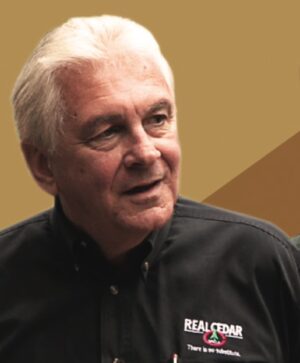
Paul Mackie
This year, I get to present the Cedar Champion Award to Paul Mackie of the Western Red Cedar Lumber Association. Paul is working for our co-operative marketing organization with a laser focus on ensuring Cedar makes it into projects and markets that will not only work for the members today, but will build the reputation of the association and the species. This triumvirate of Cedar Champions are very different people with very different career paths, but all three share the same trait – they are mission driven individuals who believed that cedar needed to be handled a certain way and never let the easy solutions supplant the right one.
I will try to give a brief and moderately accurate history of Paul’s path to cedar champion status. Like many of us, Paul’s journey in the lumber industry is rooted in family. His Great Grandfather was involved in two Seattle area shingle mills in the early 1900s that ran until the 60’s. His father was in the business as well and upon his return from the great war he ran a pine mill in Tennessee and then moved back to Seattle where he worked in export to Japan, timber cruising, owned shingle mills and a lumber yard. He formed Lumbermen’s communication in the 1950s and worked as the executive director for the Western Lumber Marketing Association. In 1961, Paul’s family moved to Eugene where his dad eventually formed Wood Traders with Paul as a partner.
Paul worked in the business through school in plywood mills. He was an English Lit major with plans to become a lawyer. He graduated college in 1973 and passed the LSAT, but his bridge habit hurt his GPA, so law school wasn’t to be. When he graduated, he gave up his $900/month plywood mill job for a $600/month white collar job trading hemlock that was already in transit on the rails. He told me that at United Alpine, they were competing with Seaboard hemlock that was going through the Panama Canal from BC. The hemlock he sold was already moving – they may have 100 or so items to sell and 99 were on a moving box car.
He worked for Bittle then United Alpine for about 3 years, then he took this knowledge to Wood Traders where he partnered with his dad. They were selling Fir, Hemlock and SPF from mills to US lumber yards. The business was predicated on using the set cost per hundred BF to get wood from the west coast to the mid west or east coast. In 1980, the Staggers Rail Act changed who was in control and the set rates and rail routing were out the window. This was bad news for Wood Traders and eventually they were forced to close up shop around 1985. It did have a silver lining, however as it was the cause of a heated argument between paul and the traffic manager at Willamette Industries – Roberta. Roberta and Paul have been married since the early 80’s and still haven’t settled the argument. After Wood Traders, Paul spent a decade at Dunn and Bradstreet in Seattle underwriting accounts receivables before he interviewed for the WRCLA in 1995. His first role with the association was a 13-month contract position to build purchase displays, replenish literature and do training at retail locations. Back in those days, he might be allotted 10 minutes in the aisle of a Home Depot to do the training.
The association hired Paul as it had received a $1M grant from the Canadian Government to market cedar in the wake of a massive LP Sawdust composite siding failure that paid out almost $1 billion. When Paul’s program was a success and the funding was extended another 6 months, the WRCLA board decided to make Paul’s position as northwest field rep permanent. Paul was hired by Ken McClelland and learned about cedar under Arnie Nebblesick who was the first WRCLA Staff members when it spit from the WWPA. Paul was a sponge and got inspiration form Arnie and Ken, passionate cedar folks like Doug Nelson and the other field reps – Arnie, Tony, Steve, and now Jay. Paul has developed a reputation as a take no prisoners cedar specifier. When Paul sees an iconic job being designed that could go cedar or could go elsewhere, his pit bull teeth get into that bone and never let go. When New York University was designing a job that could only be cedar if it was straight 16’s of FSC certified 5/4×10 VG, FSC Certified, Fire Treated… most walked away, but Paul made sure the job ultimately was done in Cedar and that the spec was made more realistic. The Sandy high school in Portland now displays over $500K worth of western red cedar thanks to 3 years and hundreds of interactions of determined effort from Paul. When architects went away from v-joint to flush and began having problems with gaps forming in flush joint T&G, he relentlessly pushed fine line reveal – and now it’s everywhere.
Paul works very hard on projects and to advocate for his members and his species, but I can say from my own experience he expects all of us to work just as hard to represent the species properly. Paul works for the members, but he has never been afraid to manage up to the members – I think everyone in this room knows what I’m talking about. Paul has lived and breathed cedar for nearly 30 years. Every day he seeks to convert someone new into a cedar champion. Paul has shown what a field rep can do when they are mission driven. The board and executive will look to add additional field reps in the near future and that is in no small part because we have watched Paul punch above his weight class for 3 decades. All of us in the association have benefited from Paul’s passion and integrity.